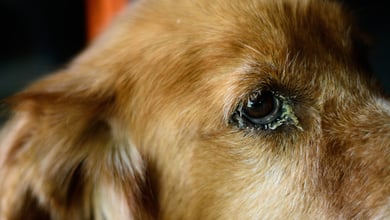Pink Eye (Conjunctivitis) in Dogs: Symptoms & Causes

Table of Contents
Most of us recognize conjunctivitis, or pink eye, as a condition affecting humans. However, it's crucial to understand that our four-legged companions are not immune to it. In this guide, we'll dive deep into pink eye in dogs, highlighting its symptoms, causes, and effective treatments.
Whether you're a devoted pet owner looking for guidance or someone keen on canine health, this guide offers all the insights you need.
- Dogs can develop various forms of pink eye, including viral, bacterial, and allergic conjunctivitis.
- Recognizing symptoms such as redness, tearing eyes, discharge, squinting, swollen eyelids, and pawing at the face is crucial for identifying conjunctivitis in dogs.
- Veterinary care is essential for properly diagnosing, treating, and managing conjunctivitis in dogs.
Let’s start!
Can Dogs Get Pink Eye (Conjunctivitis)?
Yes, dogs can get pink eye. Conjunctivitis, or pink eye, is the inflammation of the conjunctiva, a thin, transparent membrane that covers the eye's front surface and lines the inner eyelids. This condition manifests as redness, swelling, and discharge.
Although commonly seen in humans, dogs of all breeds and ages are susceptible, with causes ranging from viral and bacterial infections to allergic reactions.
How Do Dogs Get Pink Eye?
Dogs can develop pink eye (conjunctivitis) from various causes, ranging from infections and physical trauma to specific medical conditions. Here are the common causes of pink eye in canines further broken down:
Infections
Bacterial, viral, and fungal infections, such as Canine Distemper Virus or Blastomycosis, can lead to conjunctivitis.
Related reading: Dog Eye Infections
System disorders
Allergic conjunctivitis, plasma cell conjunctivitis, and pemphigus, which affect the immune system, can also result in pink eye.
Tear film issues
Reduced tear production, as seen in conditions like Keratoconjunctivitis Sicca (Dry Eye) can make the eye susceptible to irritation and inflammation.
Tumors
Cancerous or non-cancerous tumors in or around the eyes can cause inflammation and conjunctivitis.
Eyelid disorders
Eyelid abnormalities such as entropion, ectropion, and eyelash disorders can irritate the eye surface and lead to pink eye.
Tear duct disorders
Blockage of the tear duct can cause swelling and conjunctivitis.
Trauma
Scratches to the eye's surface or foreign material can result in conjunctivitis.
Glaucoma
Increased pressure in the eyeball, known as glaucoma, can cause redness and severe pain. It requires an immediate visit to the vet to prevent vision loss.
Hassle-free In-Home Pet Sick Visits
When your pet isn't feeling well, the last thing you want is a stressful trip to the vet. Our in-home sick pet visits offer a calm, stress-free alternative.
Signs & Symptoms of Conjunctivitis in Dogs
Here are common signs of conjunctivitis in dogs to keep an eye out for:
- Redness or a bloodshot appearance to the eye(s)
- Tearing eyes
- Discharge from one or both eyes (watery, cloudy, yellow, or green are all possible)
- Squinting or excessive blinking
- Swollen eyelids
- Pawing at the face
How is Pink Eye Diagnosed in Dogs?
To diagnose pink eye in dogs, vets first determine if it's the main issue or if another problem is causing it. Here's what vets typically do:
- A comprehensive visual examination of the eye, including inside the eyeball and the surrounding structures such as eyelids, tear ducts, and third eyelids.
- Measurement of tear production
- Staining the surface of the eye to check for damage
- Measuring the pressure within the eyeball
If more information is needed, they might also conduct tests for bacteria or fungi, perform allergy testing, blood tests, imaging studies, or even examine eye cells under a microscope. Your vet will choose the best tests for your dog.
Treatment for Conjunctivitis in Dogs
When treating conjunctivitis in dogs, the approach is tailored to the specific cause. For bacterial infections, vets typically prescribe antibiotic eye drops or ointments.
For viral conjunctivitis, the emphasis shifts to supportive care, ensuring the eyes are kept clean and the dog remains comfortable.
In cases of allergic reactions, identifying and steering clear of the allergen becomes crucial, and the treatment might extend to using antihistamines or corticosteroids, always under veterinary guidance.
Home Treatment for Conjunctivitis in Dogs
It's vital to see a vet for dog conjunctivitis. But for mild cases or quick relief, you can try a few things at home. These include:
- Gently clean the eye area with a veterinarian-approved saline solution.
- Apply a warm compress to soothe the eyes.
- Ensuring your dog's environment is clean and free of potential irritants.
📒Note: If your dog's symptoms persist or worsen, consult with a veterinarian.
Conclusion
Conjunctivitis is an eye condition that can affect our canine companions, causing discomfort and visual disturbances. By understanding the symptoms, causes, and available treatments, pet owners can take appropriate measures to address conjunctivitis and promote their dog's eye health.
If you suspect your dog has pink eye or the symptoms worsen or persist, you must visit a veterinarian for a thorough evaluation and treatment plan.
Should My Pet Be Seen by a Veterinarian?
1. Have you noticed changes in your pet’s appetite?
2. Does your pet have diarrhea or loose stools?
3. Have you noticed changes in your pet’s thirst/water consumption?
4. Is your pet having accidents in the house?
5. Is your pet pacing and unable to settle?
6. Is your pet panting more than usual?
7. Is your pet whining or vocalizing more than usual?
8. Is your pet shaking more than usual?
9. Is your pet hiding or avoiding physical contact more than usual?
10. Is your pet more lethargic and sleeping more than usual?
11. Are you concerned about changes in your pet’s behavior?
12. Is your pet scratching their ears?
13. Is your pet licking their paws more than usual?
14. Does your pet have a rash?
15. Is your pet moving more slowly than usual or having a harder time getting up or down?
View Results
Should My Pet Be Seen by a Veterinarian?
1. Have you noticed changes in your pet’s appetite?
2. Does your pet have diarrhea or loose stools?
3. Have you noticed changes in your pet’s thirst/water consumption?
4. Is your pet having accidents in the house?
5. Is your pet pacing and unable to settle?
6. Is your pet panting more than usual?
7. Is your pet whining or vocalizing more than usual?
8. Is your pet shaking more than usual?
9. Is your pet hiding or avoiding physical contact more than usual?
10. Is your pet more lethargic and sleeping more than usual?
11. Are you concerned about changes in your pet’s behavior?
12. Is your pet scratching their ears?
13. Is your pet licking their paws more than usual?
14. Does your pet have a rash?
15. Is your pet moving more slowly than usual or having a harder time getting up or down?
Share Quiz
Frequently Asked Questions
Is conjunctivitis in dogs contagious?
Yes, depending on its cause. Bacterial and viral conjunctivitis can spread among dogs, but allergic conjunctivitis isn't contagious.
Can dogs catch pink eye from humans?
It's rare but possible. Dogs might get pink eye from humans through direct contact. However, other dogs or environmental factors are more common sources.
Is it possible for humans to get pink eye from dogs?
While pink eye is mainly a human condition, the chances of getting it from a dog are very low.
Should I consider dog conjunctivitis an emergency?
Not always. But if your dog shows severe symptoms like intense pain, swelling, or vision issues, you should see a vet immediately.
Will pink eye in dogs heal by itself?
It depends on the cause. Some cases might heal on their own, but others need veterinary care and treatment.
Can dogs go blind from conjunctivitis?
Conjunctivitis itself rarely causes blindness. However, severe or untreated cases, or related conditions, might lead to vision issues. It's essential to detect and manage it early.





